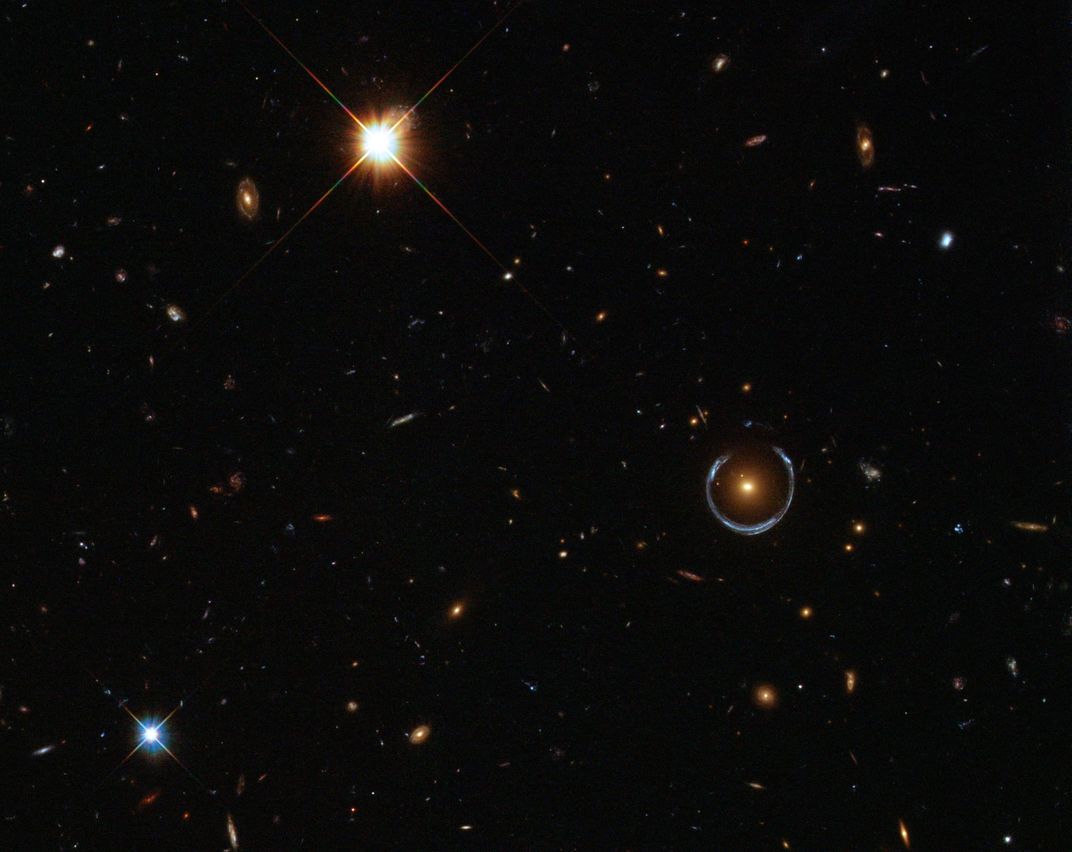In a Rare Pairing, a Venus-Like Planet Has Been Found Around a “Failed Star”
The system offers clues to the way planets and moons form and may aid in the quest to find habitable worlds across the galaxy
/https://tf-cmsv2-smithsonianmag-media.s3.amazonaws.com/filer/9e/fa/9efa10aa-9ee4-42e1-b77e-8de41d48917a/pia17998_fig1.jpg)
Astronomers hunting for planets outside our solar system just keep finding them in the darndest places. There are boiling hot Jupiters that hug their stars, rocky worlds like Earth that spin around multiple suns and even rogue planets that sail unbounded through the galaxy.
Now, astronomers using a gravitational magnifying glass have found a Venus-like planet orbiting a "failed star"—a massive but incredibly dim brown dwarf. This rarely seen pairing offers clues to the way planets and moons form, which may in turn help in the quest to find habitable worlds, whether they are Earth-like planets or life-friendly moons.
"I wouldn't say this proves anything, but it’s the first hint that there might be a universality in how companions form at all these different scales," says Ohio State University Andrew Gould, part of the team reported the find last month in the Astrophysical Journal.
Stars form when gravity pulls together cold clouds of gas and dust, and newborn stars then become surrounded by spinning disks of leftover material. Dense pockets within these disks coalesce to form planets. Similarly, Jupiter's largest moons are thought to have formed from a disk of so-called circumplanetary material around the infant gas giant.
But brown dwarfs occupy a niche in between stars and planets—they are just large enough to have begun the process of fusion, but too small to continue with it like larger stars. Intriguingly, the Venus-like world and its brown dwarf have a similar mass ratio to both Jupiter and its largest moons and to the sun and the outer icy planets. This hints that all these objects may have formed via a similar mechanism, just at different scales.
"If this object formed the same way Jupiter's moons formed, this means the process of forming moons from a circumplanetary disk like the Galilean satellites is universal," says David Kipping of Columbia University.
In this case, the newfound exo-Venus stands as a bridge between planets and moons. If its brown dwarf host was just a bit smaller, the star would really be considered a planet, and the new body would be described as an exomoon.
According to Kipping, the new system puts an upper limit on how large a moon can get compared to the object it orbits. While large bodies can be captured, a Jupiter-sized planet would not have enough gravitational clout to spawn an Earth-sized world in its circumplanetary disk. Building an Earth- or Venus-sized moon instead requires a host as massive as a brown dwarf, he says.
Figuring out such limits is important, because exomoons are of great interest to astronomers searching for habitable worlds. Although the large moons of our solar system lie too far from the sun to hold water on their surfaces, they are some of the most promising places to search for extraterrestrial life, as many boast subsurface oceans.
And astronomers think large exomoons orbiting distant gas giants could host surface water if they spin close enough to their stars. Although no exomoons have yet been discovered, instruments like NASA's Kepler telescope are eagerly searching for them.
So could this Venus-like planet host life? Probably not, says Gould. With no fusion-driven heat in their cores, brown dwarfs are incredibly dim, and this planet is likely too far from its star to be warm enough for habitability. Unfortunately, the method used to find the dark planet around a faint star presents challenges to further study.
To find the Venus-like planet, scientists used a planet-hunting technique known as microlensing, which relies on light from a star behind the brown dwarf. As the background star shines, the brown dwarf's gravity bends and magnifies its light in such a way that scientists can identify not only the extremely dim star but also its orbiting planet.

"It is extremely difficult—although probably not impossible—to see planets around brown dwarfs by any technique except microlensing," says Gould. "In the case of a brown dwarf, even though it's emitting little or no light, [microlensing] can still betray its presence."
But because microlensing relies on the precise lineup of the system with a background star, researchers can't easily study these worlds again, so they can't determine attributes such as the planet's atmosphere, which would help characterize its habitability.
The biggest challenge with microlensing, Gould says, is pulling out important details. The signal wraps up all the information about the mass, distance and velocity of the target star (and any orbiting worlds) compared to the background star. But astronomers often don't have enough data to tease them apart—much like if I gave you the square footage of my house and told you to determine its length, width and the number of floors.
Binary systems, where two stars are locked in a mutual orbit, almost always contain an extra piece of information that helps astronomers get the mass of any orbiting planets. On top of that, this newfound system lies about ten times closer to Earth than most previously known microlensed systems, making variations in its signal—and ultimately the planet's mass—easier to pull out.
Based on statistical evidence, Gould says that rocky planets around low-mass stellar pairs like this one are likely quite common, enough so that every star in a similar system may boast a terrestrial world. A small portion of those found in the future may well be warm enough to hold liquid water on their surface, and as microlensing surveys improve and space-based efforts continue, more of these worlds should be identified.
"We think that we're really just scratching the surface of what microlensing can tell us about systems people aren't even really thinking about right now," Gould says. "We're looking forward in the future to more microlensing detections."
/https://tf-cmsv2-smithsonianmag-media.s3.amazonaws.com/accounts/headshot/NTR_headshot.jpg)
/https://tf-cmsv2-smithsonianmag-media.s3.amazonaws.com/accounts/headshot/NTR_headshot.jpg)